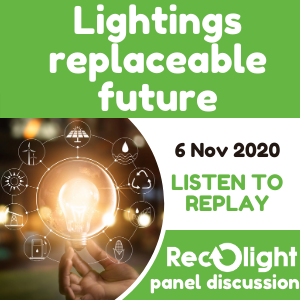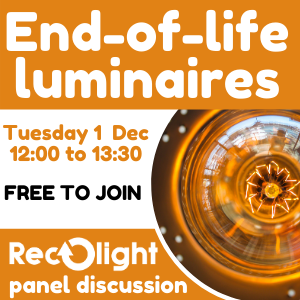A series of Recolight webinars looking at lighting and the circular economy have heard from experts across the lighting industry. They covered legislation for lighting, circular economy principles implemented in product design by manufactures, and challenged the industry to be more sustainable.
These webinars just scratched the surface, and Recolight will delve into questions raised by hosting a series of panel discussions.
 Lighting’s replaceable future
Lighting’s replaceable future
The first panel discussion held on 6 November explored:
- How can we make lighting products more sustainable?
- Will the return of replaceable light sources, drivers and other components contribute to sustainability in the lighting industry,
- Is how we control and use light fittings just as important as how they are produced.
Chairing and introducing the event was Ray Molony and on the panel: representing lighting manufacturers Helen Loomes of Trilux and John Gorse of Signify, specifiers Dave Tilley and Kevan Shaw, and from the regulation view point Ourania Georgoutsakou of LightingEurope and Nigel Harvey of Recolight.
 The discussion was based on the findings of the ReproLight project. The project looked at two differing approaches: 1)A luminaire that can last considerable length of time, maintenance free, with material optimized in design. 2) Luminaires designed for use with replaceable components; there is an inevitable trade off between energy efficiency and material efficiency.
The discussion was based on the findings of the ReproLight project. The project looked at two differing approaches: 1)A luminaire that can last considerable length of time, maintenance free, with material optimized in design. 2) Luminaires designed for use with replaceable components; there is an inevitable trade off between energy efficiency and material efficiency.
Discussion points raised
-
- EU Eco design regulations will take into account diversity of design and applications. From September 2021 packaging will have to specify if the control gear is replaceable.
- Luminaires that have replaceable components and can be dismantled simply should be embraced. We want to be able to repurpose a product, we want to change people’s relationship with lighting, not selling a product but a service. Embracing replaceability will help achieve sustainability targets .
- Too much focus is put on luminaire design. By bringing in control systems, the data generated will give a greater understanding of the whole energy consumption of a luminaire, and could prolong luminaire life.
- Material and energy efficiency is all part and parcel of tackling the climate emergency. We have to think more fundamentally about how we’re going to make sure that products can stay in use for longer and longer and replaceability is a way of helping us to achieve that.
- Maintenance is important and still has to be taken into account in an LED scheme.
- Viability of 3d Printing. We have light fittings that are long life high quality and come with a decent framework. What we need is a digital file for our 3D printers and we can change the look, shape, and form of the luminaire.
Summarising, Ray Molony commented that “A push to use smart controls would reveal the amount of energy luminaires use, and could track the efficiency of each component.”
 End of life luminaires
End of life luminaires
The next Recolight panel discussion is scheduled for
Tuesday 1 December 12:00 to 13:30
The panel will explore the options for luminaries at the end of life. Looking at ways to extend their life through reuse, refurbishment, extended warranties, & leasing business models. How do we truly make lighting a part of the Circular Economy’?
- What happens to light fittings when they’re removed from a ceiling?
- If we’re lucky, the luminaires are recycled. If we’re not, they end up in a skip.
- Could they be reused, repurposed, upgraded, returned to original manufacturer?
- How do we maximise the sustainability of the products we make, sell, and specify?
 Our panel of industry experts will discuss how these opportunities can become a reality for the lighting industry.
Our panel of industry experts will discuss how these opportunities can become a reality for the lighting industry.
Again, it is free to join, please follow this link to register.
